If you are planning to want the best fintech app design, one of the worst mistakes you can make it, underestimate app design!
User interface and user experience can make an app or break it.
But how? Why is it so important? And how do you get it right?
These and all other questions related to fintech mobile app design will be discussed, covering importance, case study, a dive into target users, and so much more.
So with this being said, let’s get right into it:
Why is App Design Important?
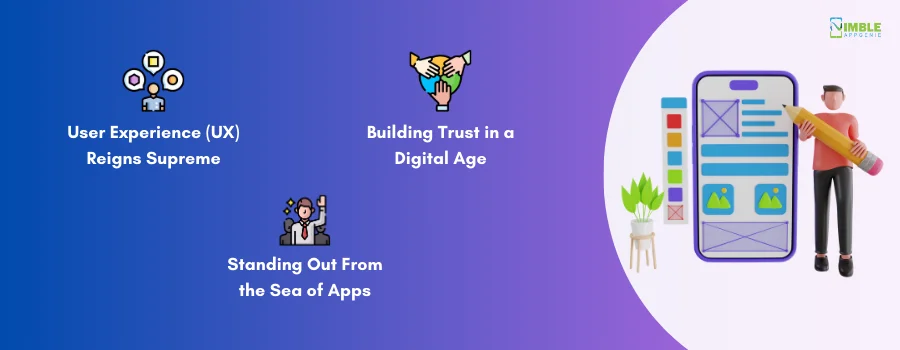
Want to develop a fintech app that disrupts the market?
Focus on fintech app design
In the fast-paced world of fintech, app design isn’t a decorative afterthought – it’s a critical differentiator.
Here’s why a well-crafted app is the secret weapon for successful fintech businesses:
► User Experience (UX) Reigns Supreme
Let’s face it, users have no patience for clunky interfaces. A staggering 70% of users abandon poorly designed apps.
In the realm of finance, where trust and ease of use are paramount, a smooth UX is essential.
An intuitive interface, clear navigation, and a frictionless workflow ensure users feel comfortable and confident managing their finances within the app.
► Building Trust in a Digital Age
Fintech apps are challenging the status quo of traditional financial institutions, changing the banking industry forever.
With a well-designed app, you can bridge the trust gap.
A report found that 73% of customers cite trust as a major factor when choosing a financial services provider.
Prioritizing data security and user privacy through design elements that emphasize security measures is key to building user confidence.
► Standing Out From the Sea of Apps
The app stores are overflowing with choices – over 4.8 million on the Google Play Store alone (Statista, as of Q1 2023).
A well-designed app with a distinct and memorable brand identity can be your saving grace. Fintech apps need to strike a balance between professionalism and user-friendliness.
Utilizing design elements that are both visually appealing and informative will help your app rise above the noise in a crowded marketplace.
Understanding Fintech App Users
If you want to nail fintech mobile app design, you need to understand your target audience.
Fintech app users span from tech-savvy millennials looking for banking alternatives to older generations seeking simplicity in digital finance.
For instance, if you want to create a budgeting app, your target audience can be:
► Budgeting Pro:
Or, if you are creating an investment platform, your target audience can look at something like this:
► Investment Enthusiast

All in all, the general idea is that recognizing this diversity is key to designing apps that resonate with varied financial behaviors and needs.
Users are drawn to fintech for more than just convenience; they seek empowerment over their finances, instant transactions, and features like peer-to-peer payments.
They demand simplicity, robust security to protect their data, and accessible support for navigating financial services.
Successful fintech apps hinge on a deep understanding of user demographics, motivations, and expectations.
A design that prioritizes simplicity, security, and personalization, while addressing common challenges, will create a user-centric experience that empowers individuals in their financial journeys.
Emoji Payments? You bet! Believe it or not, some Chinese fintech apps allow users to personalize their payments with fun emojis. This injects a lighthearted touch into what might otherwise be a mundane financial transaction.
Key Design Principles for Fintech Apps
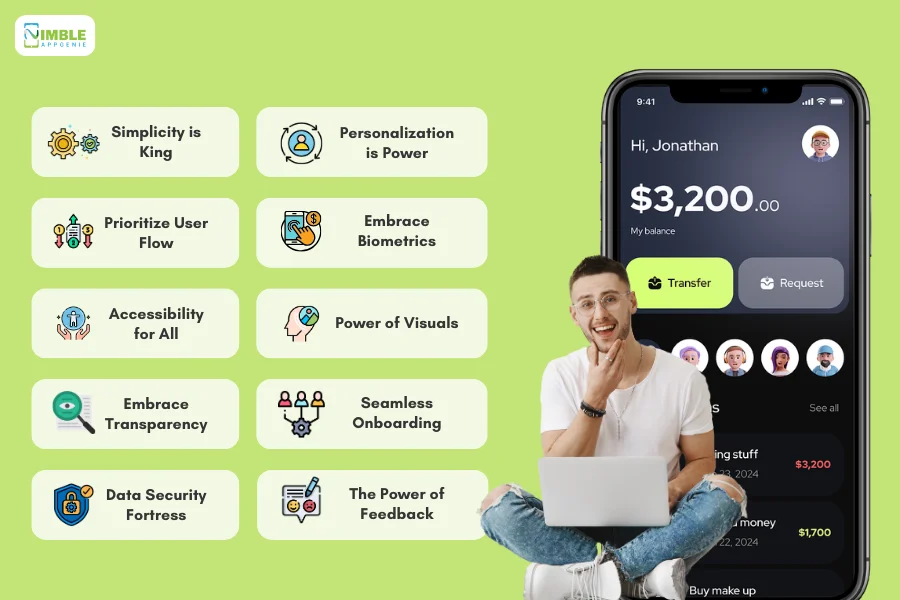
It’s time to look at fintech app design principles.
UI as well as UX Design Principles plays a very important role in dictating the success of your fintech app in the market.
So, it’s important to consider these principles when dealing with fintech app design.
1. Simplicity is King
In the fast-paced world of finance, users don’t have time to decipher complexities.
Prioritize clarity and ease of use from the get-go. Avoid overwhelming users with intricate interfaces or an overload of information.
Focus on intuitive navigation with clear labels and icons. Every element, from buttons to menus, should be self-explanatory, allowing users to complete tasks quickly and efficiently.
2. Prioritize User Flow
Imagine your app as a highway – users should be able to navigate seamlessly to their financial destinations.
Apply this in fintech app UI UX, and map out the user journey for common tasks, like money transfers or bill payments.
This will ensure a smooth, logical flow that minimizes steps and eliminates friction points.
Plus, don’t forget to anticipate user needs and guide them intuitively through the process with clear prompts and progress indicators.
3. Accessibility for All
Fintech shouldn’t discriminate. Design your fintech app with inclusivity in mind.
Consider users with visual impairments or dexterity limitations.
Incorporate features like high contrast themes for better readability, larger fonts for easy viewing, and voice-enabled controls for hands-free interaction.
By ensuring accessibility, you tap into a wider user base and create a more equitable financial experience.
4. Embrace Transparency
Building trust is paramount in the realm of finance.
Therefore, your fintech app design should be upfront and transparent about everything from fees and interest rates to terms of service and data usage.
Provide clear explanations for financial products and investment options, avoiding complex jargon. Users deserve to understand exactly how their money is being managed within the app.
5. Data Security Fortress
In today’s digital age, security is sacrosanct.
Your fintech app should be a fortress safeguarding user data.
For this, you can implement robust security measures like industry-level encryption, multi-factor authentication for logins, and secure protocols for transactions.
Visually communicate these security features through icons and badges to instill confidence in users about their financial information.
Some budgeting apps incorporate game mechanics to make saving money more engaging. Users might earn points for reaching milestones, unlock badges for consistent saving habits, or even compete with friends on leaderboards. This gamification approach can make financial responsibility feel more rewarding.
6. Personalization is Power
A one-size-fits-all approach doesn’t work in fintech. You need to cater to individual user needs and financial goals.
For this, you can offer features like customizable dashboards that display relevant financial information.
Integrate goal-setting tools that allow users to track progress towards savings targets or investment aspirations. Consider personalized investment recommendations based on risk tolerance and financial profiles.
By empowering users to manage their finances in a way that aligns with their unique needs, you foster a deeper connection with the app.
7. Embrace Biometrics
Convenience and security can go hand-in-hand. That’s where biometric authentication comes in.
Leverage fingerprint and facial recognition technology to provide users with secure and convenient logins and transaction approvals.
This eliminates the need to remember complex passwords and streamlines the user experience.
However, ensure clear opt-in options for biometric authentication and prioritize user privacy by clearly outlining how this data is stored and used.
8. Power of Visuals
People are visual creatures.
Don’t just tell users about their finances, show them!
Leverage data visualization tools like charts, graphs, and progress bars to present financial information in a clear and engaging way in your fintech system design.
Charts can depict spending habits, track investment growth, or visualize budget breakdowns.
By utilizing visuals effectively, you can simplify complex financial data and empower users to make informed financial decisions.
9. Seamless Onboarding
First impressions matter – especially in fintech apps.
Make the initial setup process effortless.
Offer clear instructions and minimize the required information during account creation. Consider social login options or pre-filled forms based on user-provided details to expedite the process.
A smooth onboarding experience sets the tone for a positive user experience and encourages long-term engagement with the app.
10. The Power of Feedback
The best fintech app designs are constantly evolving.
Integrate user feedback mechanisms to gather valuable insights.
Utilize surveys, in-app feedback forms, and A/B testing to continuously improve the app experience.
Actively listen to user suggestions and concerns, and prioritize addressing pain points to optimize the app’s functionality and user journey.
By fostering a culture of feedback, Nimble AppGenie can ensure its fintech apps stay at the forefront of user needs and market trends.
Fintech App Designing Best Practices & Trends
Here are some lessons for fintech startups who want to design an app that makes a difference.
In this section of the blog, we shall be looking at some major problems and their solutions.
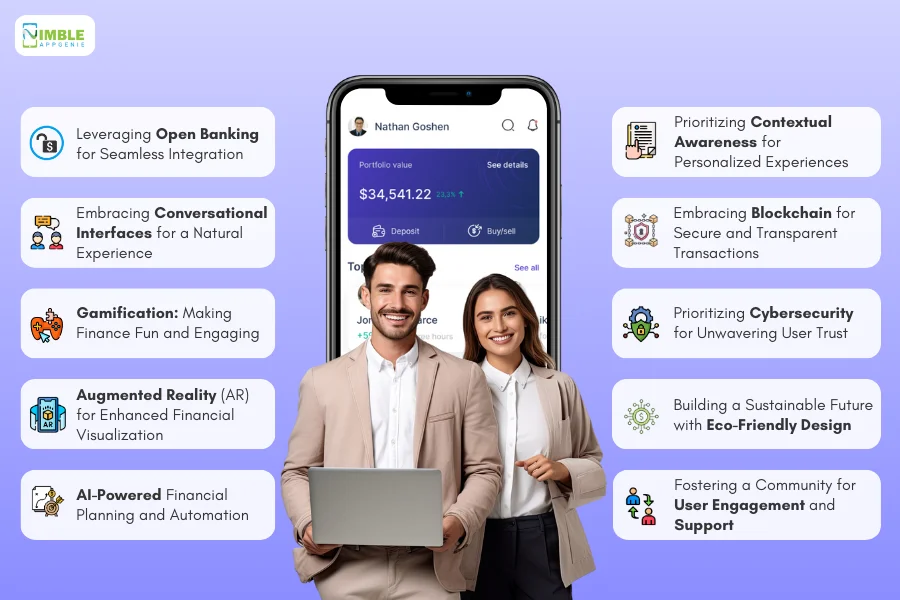
Therefore, with this being said, let’s get right into it, starting with:
Leveraging Open Banking for Seamless Integration
Problem: Fragmented financial data across institutions hinders holistic financial management.
Solution: Utilize Open Banking APIs to securely connect with various financial accounts.
This enables users to view all their financial data (account balances, transaction history, etc.) in one centralized location within the fintech app design.
This streamlines budgeting, simplifies expense tracking, and empowers users to make informed financial decisions based on a consolidated view of their finances.
Embracing Conversational Interfaces for a Natural Experience
Problem: Traditional app interfaces with menus, buttons, and forms can feel impersonal and static.
Solution: Integrate chatbots and voice assistants powered by AI (Artificial Intelligence) to provide a more natural and conversational user experience.
Users can interact with the app in a way that mimics real-life conversations.
Imagine asking questions like “what was my grocery bill last month?” or initiating transactions like “transfer $100 to my savings account” through a chat interface.
Voice assistants can further enhance accessibility, allowing users to manage finances hands-free with simple voice commands.
Also Read: Voice Payment Trends
Gamification: Making Finance Fun and Engaging
Problem: Financial management can feel like a chore for some users, leading to disengagement and missed opportunities for financial wellness.
Solution: Incorporate gamification elements like points, badges, and leaderboards to make financial tasks more engaging.
Users can earn points for completing tasks like setting financial goals, making regular deposits, or tracking expenses.
These points can then be redeemed for virtual rewards or unlock new features within the app design.
Leaderboards can foster a sense of healthy competition, motivating users to improve their financial habits.
By gamifying finance, Nimble AppGenie can transform what might feel like a burden into a rewarding and interactive experience.
Did you know that the colors used in a fintech app can subconsciously influence user behavior? Studies suggest that blue evokes trust and security, while greenness is often associated with growth and wealth. Understanding color psychology can be a powerful design tool for fintech apps.
Augmented Reality (AR) for Enhanced Financial Visualization
Problem: Traditional financial data visualization can be limited in its ability to engage users.
Solution: Explore the potential of AR technology to create an immersive user experience.
Imagine users “seeing” their budget breakdown overlaid on their physical environment.
For example, visualizing how much they spend on groceries each month superimposed on their local supermarket.
AR can also be used to visualize investment growth in a 3D format, making complex financial concepts more relatable and easier to grasp.
AI-Powered Financial Planning and Automation
Problem: Many users lack the financial expertise or time to create and manage a personalized financial plan.
Solution: Integrate AI-powered financial planning tools that analyze user data, spending habits, and financial goals.
Based on this analysis, the app can recommend personalized investment strategies, suggest budgeting adjustments, and even automate repetitive tasks like bill payments or savings transfers.
This empowers users, regardless of their financial literacy, to take control of their financial future with the help of intelligent and automated guidance.
Prioritizing Contextual Awareness for Personalized Experiences
Problem: Generic financial advice might not resonate with individual needs.
Solution: Leverage machine learning to deliver contextually aware financial guidance.
Imagine the app suggesting a coffee shop with lower spending compared to a user’s usual haunt based on location data and spending habits.
Contextual awareness personalizes the user experience and empowers informed financial decisions on the go.
Embracing Blockchain for Secure and Transparent Transactions
Problem: Traditional financial systems can be slow and opaque.
Solution: Integrate blockchain technology to facilitate secure, transparent, and faster peer-to-peer transactions.
Blockchain can revolutionize how users manage and transfer funds within a fintech app, offering greater control and immutability.
Prioritizing Cybersecurity for Unwavering User Trust
Problem: The ever-evolving cyber threat landscape demands constant vigilance.
Solution: Implement robust cybersecurity measures that stay ahead of evolving threats.
Utilize multi-factor authentication, data encryption, and regular security audits to safeguard user data and financial information.
Transparency about data security practices fosters trust and positions the app as a secure financial haven.
Building a Sustainable Future with Eco-Friendly Design
Problem: Traditional finance often relies on paper statements and physical processes.
Solution: Embrace eco-friendly design principles within the fintech app.
Encourage paperless statements, promote digital receipts, and offset the app’s carbon footprint through partnerships with sustainability initiatives.
By prioritizing environmental responsibility, Nimble AppGenie can demonstrate its commitment to a sustainable future.
Fostering a Community for User Engagement and Support
Problem: Users might feel isolated when managing their finances through an app.
Solution: Integrate social features to create a supportive community within the app.
Imagine forums where users can share financial tips, ask questions, or celebrate milestones.
A sense of community fosters user engagement and reinforces the positive impact of the fintech app in users’ financial lives.
Case Studies: Top Fintech Apps and Design Lessons
The market is filled with the best fintech apps and each of them has amazing designs.
Now, if you want to be the next big thing and create the best fintech app design, it’s a good idea to learn from the best.
Here, we shall be dissecting the design of some popular fintech apps:
1. Robinhood: Investing Made Simple and Engaging
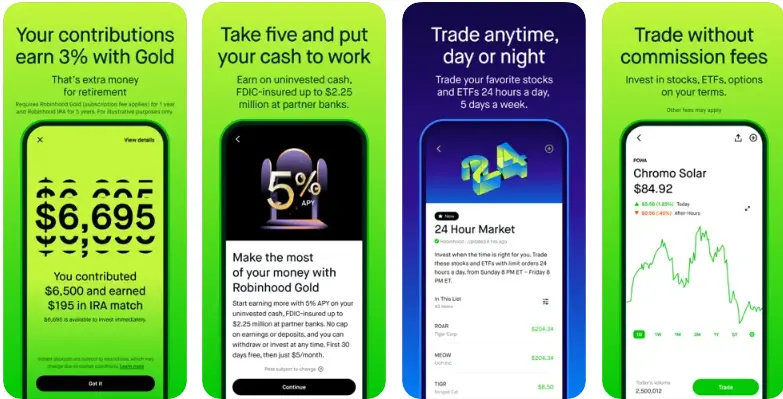
Robinhood is a commission-free stock trading app designed to make investing accessible to everyone.
Their user interface is clean and intuitive, removing the intimidation factor often associated with traditional investment platforms.
This stock trading application offers fractional shares, allowing users to invest any amount, and breaking down the barrier of high minimum investment requirements.
Here’s what we can learn from one of the top investment platforms:
- Target User: Millennials and Gen Z are interested in investing but intimidated by traditional brokerage platforms.
- Design for Trust: Robinhood prioritizes transparency with clear fee structures displayed upfront and easy-to-understand investment information presented in a jargon-free manner. Their user interface is clean, minimalist, and focuses on visual simplicity. This reduces the feeling of complexity often associated with investing, building trust with a user base that might be new to the world of stocks and options.
- Design for Engagement: Robinhood gamifies investing through fractional shares. Users can invest any amount, removing the barrier of high minimum investment requirements. They also incorporate educational resources and news feeds curated based on user interests and investment goals. This keeps users informed, engaged, and confident in making informed investment decisions.
AR Try-Before-You-Buy Investments? The future of fintech design might involve Augmented Reality (AR). Imagine using an AR app to visualize how your investment portfolio might grow over time, or see the potential impact of different financial decisions on your future finances.
2. Venmo: Social Payments with a Fun Twist
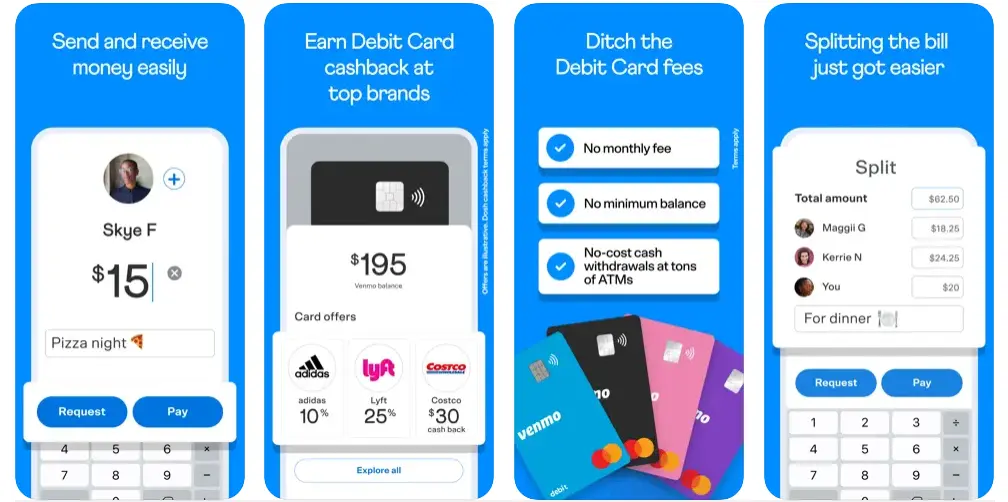
Want to create an app like Venmo? Well, you aren’t the only one.
Venmo is a mobile payment service that allows users to easily send and receive money from friends.
It prioritizes social integration, making it ideal for splitting bills, repaying loans, or sending quick gifts within friend groups.
Transactions are displayed in a social feed format, and users can personalize payments with emojis, comments, and animated avatars, adding a fun and interactive twist to money transfers.
- Target User: Young adults and social circles looking for a convenient way to split bills, send money to friends, and manage shared expenses.
- Design for Trust: Venmo prioritizes secure social integration, allowing users to connect with friends through Facebook or phone contacts, but with clear privacy settings for transaction visibility. Transactions are displayed in a social feed format with optional anonymity features, fostering transparency and accountability within friend groups while maintaining user comfort. Security is further bolstered through PINs, two-factor authentication, and real-time transaction monitoring.
- Design for Engagement: Venmo injects a social element into money transfers, going beyond just sending and receiving funds. Users can personalize payments with emojis, comments, and animated avatars. This adds a fun and interactive layer, encouraging social sharing within the app and making splitting bills or repaying friends a more enjoyable experience.
3. Mint: Personalized Financial Management with Clear Visualization
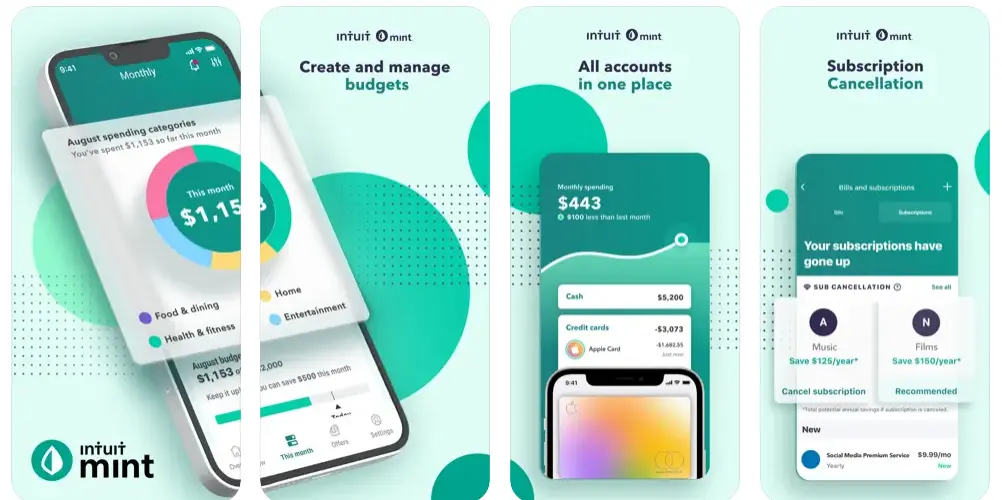
Mint is one of the best budgeting apps that helps users manage their finances, track expenses, and achieve financial goals.
It securely connects with various financial institutions, allowing users to view all their accounts in one place.
Mint offers robust data visualization tools and personalized financial insights, empowering users to make informed decisions and stay on track with their financial goals.
- Target User: Individuals looking for a comprehensive tool to manage finances, track expenses, and achieve financial goals.
- Design for Trust: Mint prioritizes data security with industry-standard encryption and a transparent data usage policy. Users can connect securely with various financial institutions through a multi-step verification process, ensuring only authorized accounts are linked. Mint also provides clear explanations of how their data is used to personalize the app experience. This builds trust by giving users control over their financial information.
- Design for Engagement: Mint offers a user-friendly interface with robust data visualization tools that go beyond basic charts and graphs. Users can personalize their dashboard with relevant financial metrics and set custom budgets. Mint utilizes progress bars, goal trackers, and motivational prompts to keep users engaged and on track with their financial management journey. Additionally, Mint offers personalized financial insights and recommendations based on user data, empowering them to make informed financial decisions.
That’s what you need to learn about fintech app design and design trends. With this out of the way, all that’s left to do is find a fintech expert and develop your next best app.
Nimble AppGenie, a Fintech Solution Provider, is Here to Help You
Nimble AppGenie is a fintech app development company.
We’re a passionate team of experts driven by a desire to revolutionize the financial technology landscape.
With over 7 years of experience and 700+ successful projects under our belt, we boast a remarkable 95% client satisfaction rate.
Here’s what sets us apart:
- Unwavering Expertise: Our team comprises seasoned developers, designers, and financial technology gurus. We bring a wealth of knowledge and a commitment to innovation to every project.
- User-Centric Design: We believe in crafting fintech apps that people love to use. We prioritize user experience (UX) and user interface (UI) design that is not only functional but also intuitive and engaging.
- Future-Proof Solutions: We stay ahead of the curve by constantly exploring and integrating cutting-edge technologies like Open Banking, AI, and AR into our app designs.
- Security at the Forefront: Data security is paramount. We implement robust security measures and prioritize industry-standard practices to safeguard your users’ financial information.
- Proven track record: Our success speaks for itself. We’re recognized by leading industry authorities like Clutch.co, DesignRush, TopDevelopers, and GoodFirms.
Ready to build a groundbreaking fintech app? Let Nimble AppGenie be your partner in success.
Contact us today for a free consultation and discover how we can transform your vision into a reality that empowers your users and revolutionizes the way they manage their finances.
Conclusion
The future of fintech apps is bright, fueled by innovation and a user-centric approach. By prioritizing clear design principles like simplicity, accessibility, and data security, fintech apps can empower users to take control of their financial lives. Additionally, embracing emerging technologies like Open Banking, AI, and AR has the potential to revolutionize how users interact with their finances, making them more informed, engaged, and ultimately, financially well-being. As the fintech landscape continues to evolve, these design best practices will be the cornerstone of building successful apps that meet the ever-changing needs of users.
FAQs
The crux of fintech app design lies in creating an outstanding User Experience (UX). This involves more than just aesthetics; it’s about ensuring the app is intuitive, easy to navigate, and meets the users’ financial needs efficiently. An app that can simplify complex financial transactions and present information in a clear, digestible manner is more likely to retain its user base.
Building trust in fintech apps is multi-faceted. It starts with prioritizing data security through advanced encryption and multi-factor authentication to protect user information. Transparency about fees, services, and how the app uses data is crucial. Additionally, a user-friendly design that makes navigation and financial management straightforward can reinforce trust by demonstrating the app’s reliability and commitment to the user’s financial well-being.
In a market flooded with financial services apps, those that stand out typically have a unique brand identity, an exceptional user experience, and innovative features tailored to specific user needs. Whether it’s offering unparalleled insights into spending habits, seamless integration with other financial tools, or unique investment opportunities, the key is to provide value that users can’t find elsewhere.
Accessibility is crucial because it ensures the app is usable by a wide range of people, including those with disabilities. This can involve features like voice commands for users with limited dexterity, high-contrast modes for users with visual impairments, and simple, clear language for those with cognitive disabilities. Accessible design broadens your user base and is a step towards creating an inclusive digital environment.
Designing fintech apps involves understanding user needs, ensuring robust security, simplifying navigation, personalizing experiences, employing engaging visuals, and incorporating feedback loops. It’s about creating an intuitive, secure, and visually appealing interface that makes financial management accessible and engaging for all users.
An example of fintech design is the Mint app, known for its user-friendly interface that simplifies personal finance management. Key features include a comprehensive dashboard, visual data representation for easy understanding of financial information, customizable alerts, and stringent security measures to protect user data.
Fintech design refers to creating user-centric interfaces and experiences for financial technology applications. It combines functionality, security, and aesthetics to simplify complex financial tasks, ensuring the app is accessible, engaging, and trustworthy for a diverse user base.

Udai Singh is a senior content writer with over 6 years of experience in creating content for FinTech, eWallet, EdTech, and App Development. He is an expert in simplifying complex concepts and creating engaging content that resonates with the audience.
Table of Contents




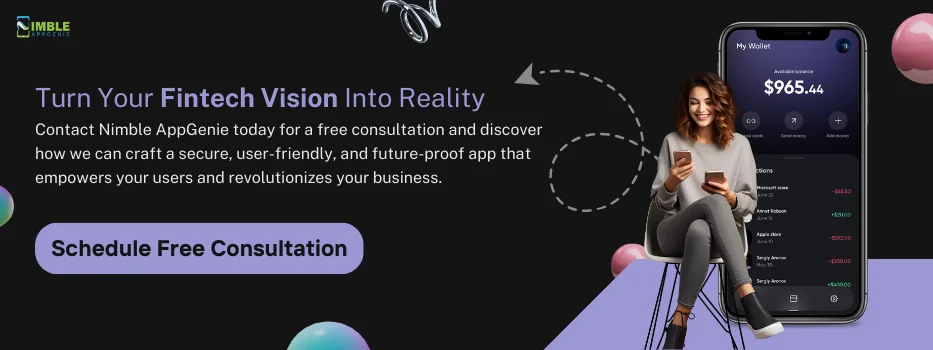
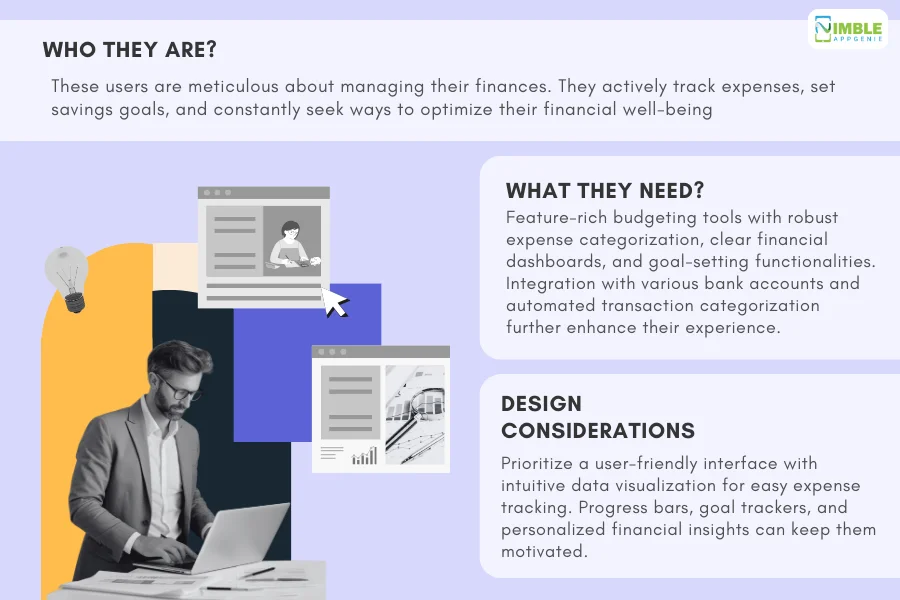

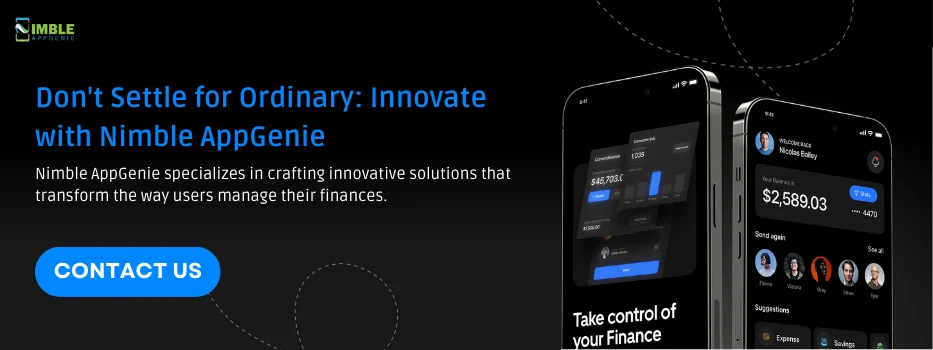








No Comments